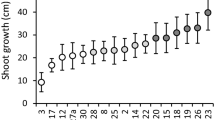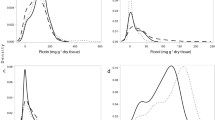Abstract
If herbivory is unevenly distributed among different types of plants, or if individual plants differ in their response to herbivory, herbivores may affect seedling growth and survival, and consequently plant population structure. In this study we examined variation in resistance to insect herbivory and in growth responses to feeding among 20 silver birch (Betula pendula Roth) genotypes representing variation within a natural population. Birch seedlings were grown in dense stands in random arrangement so that seedlings of different genotypes competed with each other. On insect exposure plots natural colonization of insects was allowed, and insect removal plots were sprayed with insecticide. Resistance to insect herbivory was measured as the inverse of leaf damage, and growth responses of seedlings to feeding were determined as the change in seedling height relative to the amount of damage. Resistance varied significantly among genotypes, but growth responses to feeding did not. In fertilized seedlings, resistance correlated negatively with height, indicating a trade-off between resistance and growth. The absence of such a correlation in non-fertilized seedlings is a sign of environmental effects on the cost of resistance. Growth responses to feeding did not correlate with either resistance or growth. Nevertheless, different effects of the actual damage on height increase changed the positions of the genotypes in the size hierarchy of the experimental populations. Thus, even moderate levels of insect herbivory can change the outcome of competitive interactions between birch genotypes.




Similar content being viewed by others
References
Augner M, Tuomi J, Rousi M (1997) Effects of defoliation on competitive interactions in European white birch. Ecology 78:2369–2377
Danell K, Huss-Danell K (1985) Feeding by insects and hares on birches earlier affected by moose browsing. Oikos 44:75–81
Fineblum WL, Rausher MD (1995) Tradeoff between resistance and tolerance to herbivore damage in a morning glory. Nature 377:517–520
Fritz RS, Roche BM, Brunsfeld SJ (1998) Genetic variation in resistance of hybrid willows to herbivores. Oikos 83:117–128
Hulme PE (1996) Herbivory, plant regeneration, and species coexistence. J Ecol 84:609–615
Jong TJ de, van der Meijden E (2000) On the correlation between allocation to defence and regrowth in plants. Oikos 88:503–508
Kinnaird JW (1974) Effect of site conditions on the regeneration of birch (Betula pendula Roth and B. pubescens Ehrh.). J Ecol 62:467–472
Laitinen J, Rousi M, Tahvanainen J (2002) Growth and hare, Lepus timidus, resistance of white birch, Betula pendula, clones grown in different soil types. Oikos 99:37–46
Laitinen M-L, Julkunen-Tiitto R, Rousi M (2000) Variation in phenolic compounds within a birch (Betula pendula) population. J Chem Ecol 26:1609–1622
Mauricio R, Rausher MD, Burdick DS (1997) Variation in the defense strategies of plants: are resistance and tolerance mutually exclusive? Ecology 78:1301–1311
Meijden E van der, Wijn M, Verkaar HJ (1988) Defence and regrowth, alternative plant strategies in the struggle against herbivores. Oikos 51:355–363
Mutikainen P, Walls M (1995) Growth, reproduction and defence in nettles: responses to herbivory modified by competition and fertilization. Oecologia 104:487–495
Mutikainen P, Walls M, Ovaska J, Keinänen M, Julkunen-Tiitto R, Vapaavuori E (2000) Herbivore resistance in Betula pendula: effect of fertilization, defoliation, and plant genotype. Ecology 81:49–65
Mutikainen P, Walls M, Ovaska J, Keinänen M, Julkunen-Tiitto R, Vapaavuori E (2002) Costs of herbivore resistance in clonal saplings of Betula pendula. Oecologia 133:364–371
Pilson D (2000) The evolution of plant response to herbivory: simultaneously considering resistance and tolerance in Brassica rapa. Evol Ecol 14:457–489
Potvin C, Lechowicz MJ, Tardif S (1990) The statistical analysis of ecophysiological response curves obtained from experiments involving repeated measures. Ecology 71:1389–1400
Price PW (1991) The plant vigor hypothesis and herbivore attack. Oikos 62:244–251
Purrington CB (2000) Costs of resistance. Curr Opin Plant Biol 3:305–308
Ritchie ME, Olff H (1999) Herbivore diversity and plant dynamics: compensatory and additive effects. In: Olff H, Brown VK, Drent RH (eds) Herbivores: between plants and predators. Blackwell, Oxford, pp175–204
Rousi M, Tahvanainen J, Uotila I (1991) A mechanism of resistance to hare browsing in winter-dormant European white birch (Betula pendula). Am Nat 137:64–82
Rousi M, Tahvanainen J, Henttonen H, Uotila I (1993) Effects of shading and fertilization on resistance of winter-dormant birch (Betula pendula) to voles and hares. Ecology 74:30–38
Rousi M, Tahvanainen J, Henttonen H, Herms DA, Uotila I (1997) Clonal variation in susceptibility of white birches (Betula spp.) to mammalian and insect herbivores. For Sci 43:396–402
Silvertown J, Charlesworth D (2001) Introduction to plant population biology, 4th edn. Blackwell, Oxford
Stowe KA (1998) Experimental evolution of resistance in Brassica rapa: correlated response of tolerance in lines selected for glucosinolate content. Evolution 52:703–712
Stowe KA, Marquis RJ, Hochwender CG, Simms EL (2000) The evolutionary ecology of tolerance to consumer damage. Annu Rev Ecol Syst 31:565–595
Strauss SY, Agrawal AA (1999) The ecology and evolution of plant tolerance to herbivory. Trends Ecol Evol 14:179–185
Strauss SY, Rudgers JA, Lau JA, Irwin RE (2002) Direct and ecological costs of resistance to herbivory. Trends Ecol Evol 17:278–285
Weis AE, Hochberg ME (2000) The diverse effects of intraspecific competition on the selective advantage to resistance: a model and its predictions. Am Nat 156:276–292
Acknowledgements
We are grateful to the Punkaharju Research Station of the Finnish Forest Research Institute, in particular to Matti Rousi and Hanni Sikanen, for facilities, advice and help. We thank Helena Hakkarainen, Risto-Matti Heinilä, Jussi Toivomäki, Merja Tiainen and Johanna Heimonen for assistance in the field, Jorma Tahvanainen for helpful comments on the manuscript and Joann von Weissenberg for checking the English language. This work was funded by the Academy of Finland (grant 68726).
Author information
Authors and Affiliations
Corresponding author
Rights and permissions
About this article
Cite this article
Prittinen, K., Pusenius, J., Koivunoro, K. et al. Genotypic variation in growth and resistance to insect herbivory in silver birch (Betula pendula) seedlings. Oecologia 137, 572–577 (2003). https://doi.org/10.1007/s00442-003-1384-3
Received:
Accepted:
Published:
Issue Date:
DOI: https://doi.org/10.1007/s00442-003-1384-3




